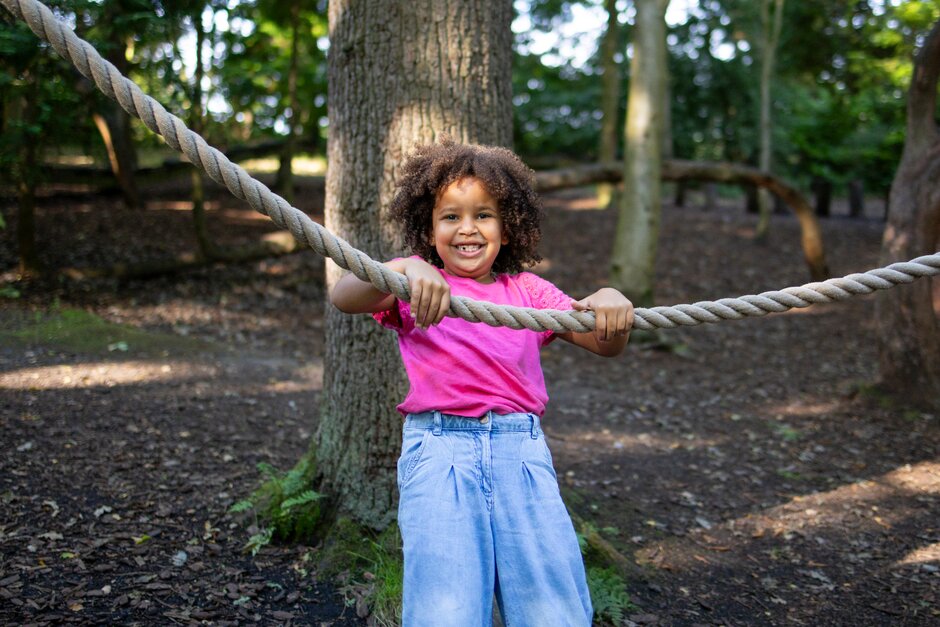Physical Development
Playing outdoors is linked directly to a child’s physical development and stronger fine and gross motor skills. Natural outdoor spaces are uneven and inconsistent and therefore improve children’s balance, coordination, agility and encourage movement in ways that improve their muscles, bones and physical endurance. By creating space for learners to play in nature, they can create a positive relationship with the natural world whilst improving their physical development. Learners can grow an appreciation for their environment by listening to bird song and interacting with flora and fauna.
Adult-led Activity Suggestions
- Develop learner’s fine and gross motor skills by encouraging them to build a simple bow and arrow. Learners will need to look closely whilst choosing the perfect natural material for their bow’s and develop their fine motor skills using simple tools. After the bow and arrows are complete a discussion can be facilitated surrounding creating things from wood instead of plastic and how long each material takes to turn back into dirt. You can then create targets from reused cardboard and write your nature-based targets on them.
- Every learner can connect to nature and enjoy an early introduction to woodwork through whittling wood with potato peelers. This helps learners to build fine and gross motor skills whilst being creative in nature and exploring the multiple layers of different materials.
- Learners can strengthen their fine and gross motor skills in many ways in nature. Bring your outdoor area to life with this save our seeds Mr Scarecrow activity in which children use natural objects and old clothes to create their own scarecrow to protect their plants and seeds from birds and introduce the concept of a food chain.
- Develop learners’ fine motor skills and connection to nature by creating seedbombs. This will allow your children to get mucky and take part in planting in a fun and creative way, whilst helping them to understand what a seed needs to thrive.
- Nature Park activity: Anatomy of a Tree – Children work together to become a tree. In groups of six each child chooses a part of the tree to become. The children work together to embody a tree, thinking about the roles of each element:
Roots – soak up water and minerals from the soil, hold the tree in the ground.
Tree Trunk – provide structure for the tree from the ground to the crown, transfers water and minerals from roots to leaves.
Bark – Protects the tree from bad weather and dieses.
Branches – Provide structure for the leaves, flowers and fruit.
Leaves – Absorb sunlight to turn into food for the tree to grow.
Fruit – A juicy fruit with a seed at the centre, the role of this for reproduction
Continuous Provision: Tree Climbing and Spider Playscape
Take a walk around your setting to look for any natural spaces that could be used for nature play, for example: trees with low branches, a path through long grass, or natural undulations in the space.
Next, provide a range of large and small natural objects (logs, benches, tree stumps, leaf mounds, rope, twigs, bamboo canes) for learners to create obstacle courses for a ‘bug Olympics’, such as tunnels to crawl through, platforms to jump off, floor ladders to tiptoe through, buckets or hoops to feed the insects balls/beanbags. This will support body strength, balance, coordination and agility.
Introduce interesting insects each week and allow learners time to imagine that they are the chosen insect, encouraging them to think about how the insect has adapted to live in their habitat. Support learners with open questions: ‘Where might that insect live?’ ‘What might it need to stay alive?’
Nature Park activity: Points of view for younger learners - this activity asks learners to experience the outdoors from the perspective of wildlife, to encourage thoughtful reflection on how an animal may live in their space. This activity helps learners think about the features and behaviours of different living things and develop empathy for wildlife, through creative role play and communication.
Green Skills Developed
- Identify and Ecology Skills
- Environmental Stewardship and horticulture

© RHS, Credit: RHS / Lee Charlton
Thumbnail image: © RHS, Credit: RHS / Trevor Ray Hart
Early learning goal outcomes
- Negotiate space and obstacles safely, with consideration for themselves and others
- Demonstrate strength, balance and coordination when playing
- Move energetically, such as running, jumping, dancing, hopping, skipping and climbing